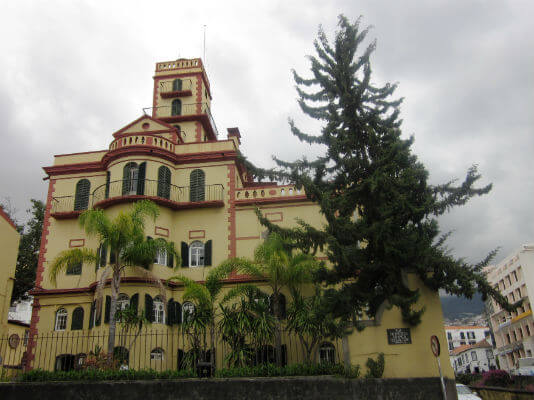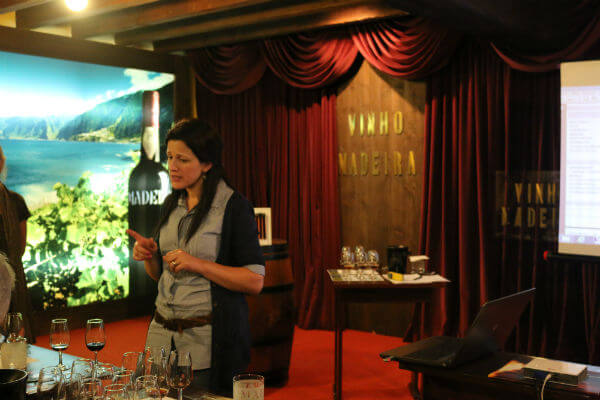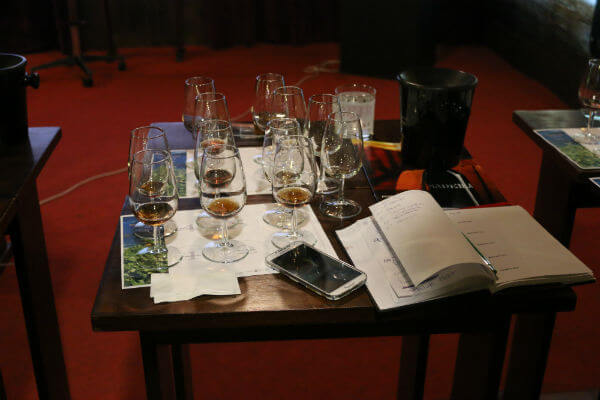Text Olga Cardoso | Translation Bruno Ferreira
The Madeira’s Institute of Wine, Embroidery and Crafts, IP – IVBAM is the responsible entity for the supervision of regional wine activities and by the certification and quality control of Madeira wine.
An entity which, with administrative and financial autonomy, efficiently cares for the consolidation and sustained growth of traditional and regional products, without however neglecting the effectively rising promotion and the quality conservation, whether at a national or international level.

The Madeira’s Institute of Wine, Embroidery and Crafts, IP – IVBAM – Photo Provided by IVBAM | All Rights Reserved
Madeira has about 400 hectares of vineyards. The agricultural lands are characterized by very steep slopes, generally in form of terraced fields. Madeira’s irrigation water is collected in the highlands of the island and is driven through channels called “levadas” that consist of an impressive 2150 Km channel system.
The most traditional conduction method is the “latada” (pergola), in which the vines are horizontally conducted. More recently there’s the espalier conduction method, which, however, can only be used in less steep slopes.
Normally the harvesting happens between mid-August and mid-October and it’s done in a totally manual way. The efforts are many, and the rituals mirror the difficulty relative to a whole smallholdings system spread over an extremely rugged terrain.
To speak of Madeira wine is like speaking of dramatism. Dramatism which is manifested not only in the overwhelming island’s view but also in its wines vinification method and long aging periods. Drama is indeed a well-defining word not only to Madeira but to everything that is portuguese. Yes, we’re a dramatic people… and it’s patent in the various aspects of our culture.
Our sound or national music is Fado – is there any other as strong, sad or deeply-felt? I can understand the difficulty that someone from the Northern Europe has, people that are usually colder, precise and devoid of such melancholic feelings. Or of someone from more cheerful and relaxed countries as are the South American ones. Indeed it must not be easy to understand all these exacerbated feelings of ours.
But, back to wine… It’s really a boast to be Portuguese. We’re young as concerns to still wines and yet we’ve won several international prizes and we’re already in publications of Wine Spectator and that confers us a place among the best world wines. However there’s still a long way to go in this area. That is if we want to maintain and increase this quality recognition.
We produce a little bit over 6 million hectoliters per year. To be on the top of the world in the quality matter, will demand a lot of us in the future. Spreading the word across the international consumers and not gird ourselves to the magazines’ recognition, will demand even more. Yes, because one thing is the magazines’ recognition and another quite different is the consumers’ acceptance and it’s that that will allow the Portuguese wines growth.
Does the press buy wines? No. Does the trade buy wines? Yes, but only to sell and while it’s financially justifiable. So, who do we have to attract? Naturally, the consumers.
Here I am, digressing again… Let’s get back to Madeira wine and IVBAM then.
This year I’ve been 4 times to Madeira and I’m about to board again. Really.. I just can’t get enough and I intend even to get more attached to the island in the future.
The last trip to Madeira, mid-November 2014, was remarkable. All of the Blend – All About Wine’s team members got quite impressed. We visited all of the Madeira wine producers and we also did a generic tasting of Madeira’s table wines.
We tried different and amazing restaurants’ and at the same time realized of its outstanding touristic potential… still so strangely forgotten when it comes to its wines.
Along the 5 trip days we tasted many high quality wines. New wines but mostly very old wines. Several of them with over 100 years, showing and proving, all of the island’s peculiarity. Some of them were tasted during the IVBAM’s MasterClass, very well led by the Head of IVBAM’s Chamber of Tasters – Rubina Vieira.

MasterClass, led by the Head of IVBAM’s Chamber of Tasters – Rubina Vieira © Blend All About Wine, Lda.
In addition this MasterClass was also nicely customized. Yes, it was a Blend – All About Wine MasterClass, born and bred for us!
We tasted twelve wines from different producers, years and varieties. Starting with a Colheita de 1996 and finishing off with a Verdelho de 1850. The ones that impressed me the most were the Sercial 1862 and the Moscatel 1875. Due to its difference and rarity, the Bastardo de 1927 didn’t went by unnoticed as well.
Complexity, concentration, deepness and balance. Those were the common characteristics to these two wines. The first one, obviously, drier and thinner than the second which reveals more viscous and molassed notes although showing itself very harmonious and with no drop of excesses. What a great wines!
But the important thing here isn’t to talk about the wines/producers and their particularities and/or differences. That’s a task to each one of my colleagues, to talk about each producer individually.
Here it’s important to talk about all of the plenitude and grandiosity of Madeira wine. Five are the noble varieties of said wine. In a sweetness crescent grading we have: Sercial, Verdelho, Boal, Malvasia and yes…the Terrantez!!!
In a sweetness grading matter we can place it between the Verdelho and Boal. But, being so rare and amounting only 1% of the island’s production can’t be even taken into account.
We’re talking about a variety that gives birth to amazing wines. Think for instance in the monstrosity of the Pereira D’Oliveira Terrantez 1880.. From the wines I tasted to this day it’s probably one of the closest to perfection.

Tasting table © Blend All About Wine, Lda.
Even though not considered a noble caste, the Tinta Negra, is a variety widely used in the Madeira Wine. Nowadays the Madeira wines produced by this variety are already considerable, not only in quantity but also in quality.
The harvesting’s priority is:
- Verdelho;
- Boal;
- Tinta Negra;
- Malvasia;
- Sercial;
As regards the vinification process and/or aging, one of two processes may occur: Estufagem or Canteiro.
Estufagem – The wine is placed in stainless steel ovens, heated by a coil system where hot water circulates for a period not less than 3 months, at a temperature between 45 and 50 degrees Celsius. After the “estufagem”, the wine is subjected to an aging period of at least 90 days at room temperature. From this moment on it can remain in stainless steel or be placed in wooden casks, until it meets the conditions that allow the winemaker to do the wine’s completion, so it can be placed in the bottle, with the necessary quality assurance. However, these wines cannot be bottled and marketed before 31th October of the second year, following the harvest. These wines are mainly blends.
Canteiro – The wines selected to age in “Canteiro” (this denomination derives from putting the barrels under wooden beam supports, called canteiros) do so in casks, usually on the higher floors of the warehouses where temperatures are higher, for a minimum period of 2 years. It is an oxidative aging in casks, developing in the wines unique characteristics of intense and complex aromas. The “canteiro” wines can only go out to the market after a minimum of three years, counted from January 1st of the year following the harvest.
The fortification consists in the fermentation stoppage and the addition of wine alcohol at 96%. The timing for the fermentation interruption is scheduled accordingly to the sweetness level intended for the wine. This method allows the outcome of four wine types: dry, mid-dry, mid-sweet and sweet.
To me, speaking of Madeira wine is like speaking of passionate wines, engaging and thrilling. I confess myself completely rendered to its charms. I’m a Madeira wine Geek … it’s true!
Voluptuousness and seduction, lust and lasciviousness, hand in hand with a huge sensitivity, with finesse and wisdom. Who said these seemingly antagonistic characteristics cannot harmonize perfectly? Might all this telluric energy, all this authenticity and depth, encapsulate the foretaste of paradise?
Voltaire said that the Tokaji had the gift to spark up even the smallest fiber of their brains. Well, the he was an illuminist and I’m not … but I think that’s what really happens to me when it comes to Madeira Wine!
But while the Tokaji is considered the King of Wines and the Wine of Kings (so once said Louis XV while offering a glass of that wine to his lover Madame de Pompadour), let me say that, for me, for his triumphant acidity and its martyr winemaking process, conditions that make it almost immortal, Madeira is much more than a wine of kings … it’s truly a GODS’s wine!
And last but not the least have a look at this outstanding video on Madeira wine.
Video provided by the Madeira’s Institute of Wine, Embroidery and Crafts, IP – IVBAM
Contacts
Instituto do Vinho, do Bordado e do Artesanato da Madeira, I.P.
Rua Visconde de Anadia, nº44
9050-020 Funchal
Tel: (+351) 291 211 600
Fax: (+351) 291 224 791
E-mail: ivbam.sra@gov-madeira.pt
Site: www.ivbam.gov-madeira.pt




Leave a Reply